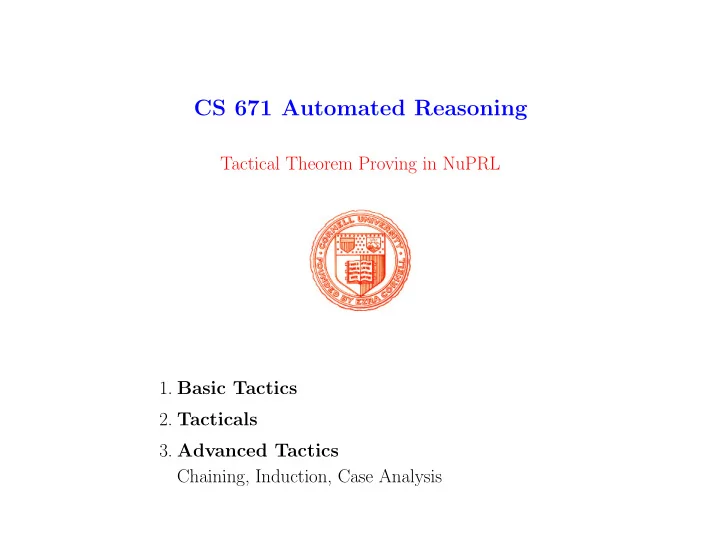

CS 671 Automated Reasoning Tactical Theorem Proving in NuPRL 1. Basic Tactics 2. Tacticals 3. Advanced Tactics Chaining, Induction, Case Analysis
Tactics: User-defined inference rules • Meta-level programs built using – Basic inference rules – Predefined tacticals . . . – Meta-level analysis of the proof goal and its context – Large collection of standard tactics in the library • May produce incomplete proofs �→ User has to complete the proof by calling ither tactics • May not terminate �→ User has to interrupt execution but Applying a tactic always results in a valid proof CS 671 Automated Reasoning 1 Tactical Theorem Proving NuPRL
Basic Tactics Subsume primitive inferences under a common name • Hypothesis : Prove ... C ... ⊢ C ′ where C ′ α -equal to C Declaration : Prove ... x : T ... ⊢ x ∈ T ′ where T ′ α -equal to T – Variants: NthHyp i , NthDecl i • D c : Decompose the outermost connective of clause c • EqD c : Decompose immediate subterms of an equality in clause c MemD c : Decompose subterm of a membership term in clause c – Variants: EqCD , EqHD i , MemCD , MemHD i • EqTypeD c : Decompose type subterm of an equality in clause c MemTypeD c : Decompose type subterm of a membership term in clause c – Variants: EqTypeCD , EqTypeHD i , MemTypeCD , MemTypeHD i • Assert t : Assert (or cut) term t as last hypothesis • Auto : Apply trivial reasoning, decomposition, decision procedures ... • Reduce c : Reduce all primitive redices in clause c CS 671 Automated Reasoning 2 Tactical Theorem Proving NuPRL
Tacticals • tac 1 THEN tac 2 : Apply tac 2 to all subgoals created by tac 1 t THENL [ tac 1 ; . . . ; tac n ] : Apply tac i to the i -th subgoal created by t tac 1 THENA tac 2 : Apply tac 2 to all auxiliary subgoals created by tac 1 tac 1 THENW tac 2 : Apply tac 2 to all wf subgoals created by tac 1 • tac 1 ORELSE tac 2 : Apply tac 1 . If this fails apply tac 2 instead • Try tac : Apply tac . If this fails leave the proof unchanged • Complete tac : Apply tac only if this completes the proof • Progress tac : Apply tac only if that causes the goal to change • Repeat tac : Repeat tac until it fails RepeatFor i tac : Repeat tac exactly i times • AllHyps tac : Try to apply tac to all hypotheses OnSomHyp tac : Apply tac to the first possible hypotheses CS 671 Automated Reasoning 3 Tactical Theorem Proving NuPRL
Supplying Parameters to Tactics • Position of a hypothesis to be used NthHyp i • Names for newly created variables New [ x ] (D 0) • Type of some subterm in the goal With x : S → T (MemD 0) • Term to instantiate a variable With s (D 0) • Universe level of a type At j (D 0) • Dependency of a term instance C [ z ] on a variable z Using [ z , C ] (D 0) CS 671 Automated Reasoning 4 Tactical Theorem Proving NuPRL
Advanced Tactics: (Inductive) Analysis • Induction – NatInd i : standard natural-number induction on hypothesis i – IntInd, NSubsetInd, ListInd : induction on Z , N subranges, lists – CompNatInd i : complete natural-number induction on hypothesis i • Case Analysis – BoolCases i : case split over boolean variable in hypothesis i – Cases [ t 1 ;..; t n ] : n -way case split over terms t i – Decide P : case split over (decidable) proposition P and its negation CS 671 Automated Reasoning 5 Tactical Theorem Proving NuPRL
Advanced Tactics: Chaining • Instantiating Facts – InstHyp [ t 1 ;..; t n ] i: instantiate hypothesis i with terms t 1 . . . t n – InstLemma name [ t 1 ;..; t n ] : instantiate lemma name with terms t 1 . . . t n • Forward Chaining – FHyp i [ h 1 ;..; h n ] : forward chain through hypothesis i matching its antecedents against any of the hypotheses h 1 . . . h n – FLemma name [ h 1 ;..; h n ] : forward chain through lemma name Optional argument Sel n • Backward Chaining – BHyp i: backward chain through hypothesis i matching its consequent against the conclusion of the proof – BLemma name: backward chain through lemma name – Backchain bc names: backchain repeatedly through lemmas and hypotheses Optional argument Using binding CS 671 Automated Reasoning 6 Tactical Theorem Proving NuPRL
Running Nuprl from a Unix machine Copy the file ˜ nuprl/utils/profile/nuprl.config.cs671 to ˜ /.nuprl.config Edit .nuprl.config and change the entries (iam "YourNameHere") (sockets 1289 1980) You may change the 0 to any number between 1-9. DO NOT change 1289! In an xterm execute xset fp+ nuprl/fonts/bdf xset fp rehash xhost +baldwin rsh baldwin /usr/bin/X11/xterm -display ‘hostname‘:0 -ls Using baldwin makes sure that there are no memory issues. You may have to adjust the -display setting. You also may want to add ˜ nuprl/bin to your path, e.g. by typing (in csh) ˜ nuprl/bin $path) into the new window. set path = ( On baldwin execute nuprl/bin/emacsb nuprl In emacs type (m-x)nuprl This should run for a minute then pop up the Nuprl windows on the display. In the navigator, go into the directories theories , then users , click MkTHY* , enter your name into [token] , click OK* and work only in the newly created theory To quit, type stop. into the emacs shell after the ML[(ORB)]> prompt. CS 671 Automated Reasoning 7 Tactical Theorem Proving NuPRL
Recommend
More recommend